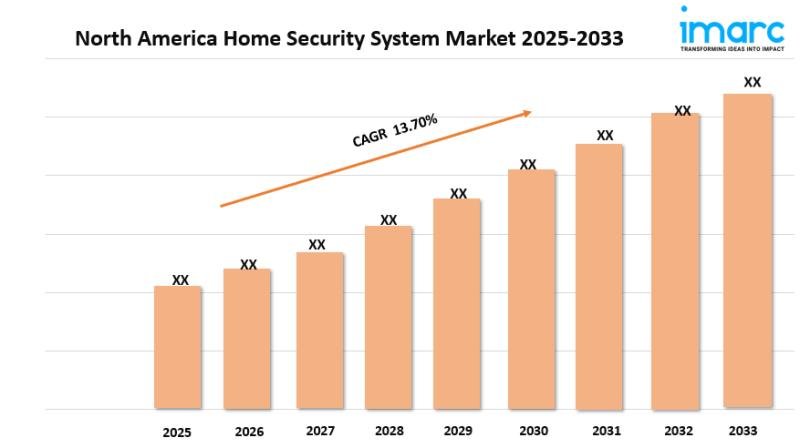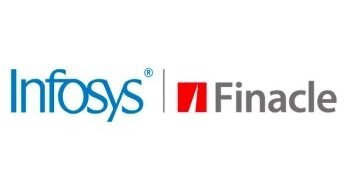North America Home Security System Market Overview
Market Size in 2024: USD 13.6 Billion
Market Size in 2033: USD 45.6 Billion
Market Growth Rate 2025-2033: 13.70%
According to IMARC Group’s latest research publication, “North America Home Security System Market Report by Integration (Self-Contained Systems, Integrated Systems), Installation Type (DIY Type, Professional Installed), Panel Type (Hard Wired Panels, Wireless Panels, Hybrid Panels, Alarm Panels), Sensor Type (Wireless Sensors, Wired Sensors), Communication Module (Professional Monitored, Self-Monitored), Equipment Type (Video Surveillance, Intruder Alarms, Electronic Locks, Fire Sprinklers and Extinguishers, and Others), Residence Type (Independent Homes, Condominiums, Apartments), and Country 2025-2033”, the North America home security system market size reached USD 13.6 billion in 2024. Looking forward, IMARC Group expects the market to reach USD 45.6 billion by 2033, exhibiting a growth rate (CAGR) of 13.70% during 2025-2033.
Download a sample PDF of this report: https://www.imarcgroup.com/north-america-home-security-system-market/requestsample
Growth Factors in the North America Home Security System Market
● Rising Consumer Awareness of Safety Needs
Growing awareness of home safety drives the North America home security system market. Burglary incidents and crime news have made homeowners focus on security. In cities like Chicago, local projects inspire people to create advanced systems. This has increased demand. ADT and similar companies have taken advantage of this. They provide easy-to-use solutions with 24/7 monitoring. This service is popular among families and elderly households. Today, safety is a priority. Easy financing options also make security systems a must-have for homes. This has driven market growth in the U.S. and Canada.
● Technological Advancements in Security Solutions
Smart security systems like Ring’s video doorbells let users watch live feeds on their phones. This boosts convenience for everyone. In 2023, SimpliSafe launched AI cameras. They can tell the difference between pets and intruders. This helps cut down on false alarms. These advancements make systems more reliable and appealing, encouraging adoption among tech-savvy consumers. Better network infrastructure, like widespread 5G, helps devices connect easily. This rise in connectivity means North American homes need better security solutions.
● Growth in Residential Construction
The growth of residential construction, especially in suburbs, is a key factor. More new homes now come with built-in security systems. Builders want to keep buyers safe and attract them. In Texas, developers such as Lennar add pre-installed security panels in new homes. They partner with brands like Honeywell. This trend increases initial sales. It also creates long-term demand for upgrades and monitoring services. Urban growth and high housing prices boost the demand for security systems in new homes. This trend drives market growth in the region.
Key Trends in the North America Home Security System Market
● Surge in Do-It-Yourself (DIY) Systems
DIY home security systems are changing the market. They provide affordable and flexible options. BBrands like Blink and Arlo offer easy-to-install cameras and sensors. They attract renters and budget-conscious homeowners. In 2024, Amazon noted a rise in sales of its Ring DIY kits. This shows a strong consumer preference for self-installation. These systems allow users to customize their setups. They can also track from a distance. Plus, there are no long-term contracts. This is different from traditional professional services. The DIY trend makes home security more accessible. It also encourages innovation among manufacturers.
● Integration with Smart Home Ecosystems
Home security systems now work well with smart home platforms. This makes them more functional and improves the user experience. Google Nest’s security cameras work with its thermostats and lights. This makes a smooth system you can control with one app. Similarly, Vivint’s systems work with Amazon Alexa, allowing voice-activated security checks. This trend appeals to consumers who want convenience and automation. A 2023 case study showed a Canadian family using integrated systems. They prevented a break-in from afar. Homeowners want smart home solutions that offer security and comfort. This need for interoperability fuels demand.
● Adoption of AI and Facial Recognition
AI and facial recognition technology are trending. They boost system accuracy and speed. Hikvision and similar companies provide cameras with facial recognition. This helps homeowners tell the difference between known visitors and strangers. A 2024 pilot program in a California neighborhood showed that AI systems cut false alerts by 30%. This change boosted user trust. These technologies also support proactive threat detection, such as recognizing suspicious loitering patterns. AI adoption is speeding up as we tackle privacy concerns with strong cybersecurity. It is becoming a key part of new home security systems.
Buy Full Report: https://www.imarcgroup.com/checkout?id=946&method=1403
North America Home Security System Industry Segmentation:
The report has segmented the market into the following categories:
Breakup by Integration:
● Self-Contained Systems
● Integrated Systems
Breakup by Installation Type:
● DIY Type
● Professional Installed
Breakup by Panel Type:
● Hard Wired Panels
● Wireless Panels
● Hybrid Panels
● Alarm Panels
Breakup by Sensor Type:
● Wireless Sensors
● Wired Sensors
Breakup by Communication Module:
● Professional Monitored
● Self-Monitored
Breakup by Equipment Type:
● Video Surveillance
● Intruder Alarms
● Electronic Locks
● Fire Sprinklers and Extinguishers
● Others
Breakup by Residence Type:
● Independent Homes
● Condominiums
● Apartments
Breakup by Country:
● United States
● Canada
● Mexico
● Others
Ask Analyst for Sample Report: https://www.imarcgroup.com/request?type=report&id=946&flag=C
Competitive Landscape:
The competitive landscape of the industry has also been examined, along with the profiles of the key players.
Future Outlook
The North America home security system market is set for strong growth. This is due to new technology and changing consumer needs. The rise of smart cities in the U.S. will link home security with city surveillance. This will create smooth safety networks. Companies like Alarm.com are working with local governments to boost community security. There is also a growing demand for energy-efficient systems. Brands like Schneider Electric are creating solar-powered security devices. More young homeowners will adopt affordable systems as 5G networks expand. The market’s future depends on balancing advanced features with privacy protections. This balance will keep consumer trust strong.
Research Methodology:
The report employs a comprehensive research methodology, combining primary and secondary data sources to validate findings. It includes market assessments, surveys, expert opinions, and data triangulation techniques to ensure accuracy and reliability.
Note: If you require specific details, data, or insights that are not currently included in the scope of this report, we are happy to accommodate your request. As part of our customization service, we will gather and provide the additional information you need, tailored to your specific requirements. Please let us know your exact needs, and we will ensure the report is updated accordingly to meet your expectations.
About Us:
IMARC Group is a global management consulting firm that helps the world’s most ambitious changemakers create a lasting impact. The company provides a comprehensive suite of market entry and expansion services. IMARC offerings include thorough market assessment, feasibility studies, company incorporation assistance, factory setup support, regulatory approvals and licensing navigation, branding, marketing and sales strategies, competitive landscape and benchmarking analyses, pricing and cost research, and procurement research.
Contact Us:
IMARC Group
134 N 4th St., Brooklyn, NY 11249, USA
Email: sales@imarcgroup.com
Tel No:(D) +91 120 433 0800
United States: +1-631-791-1145
This release was published on openPR.














